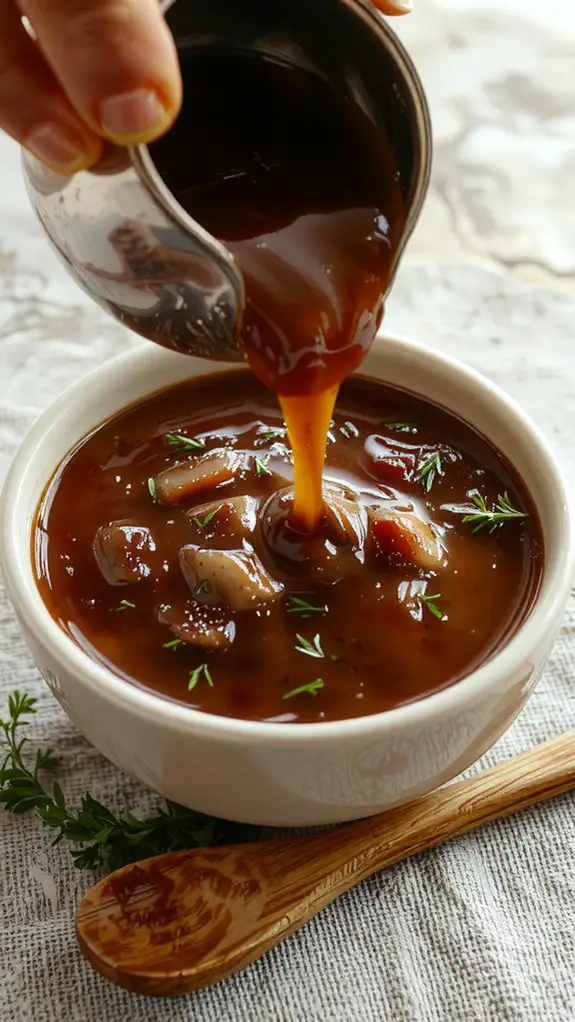I’ve always believed that a good turkey gravy can elevate a holiday meal from ordinary to unforgettable. It’s not just about the ingredients but the technique—knowing how to balance richness with depth and texture. I’ll walk you through my method, starting with the essentials and adding a few twists that make all the difference. If you’ve ever wondered why some gravies stand out, this might just be the missing piece.
Recipe
This is the only turkey gravy recipe you’ll ever need—rich, velvety, and packed with flavor that will have your guests asking for seconds. What sets it apart? It’s all about starting with the pan drippings from your roasted turkey, which infuse every spoonful with deep, savory goodness.
I’ve been making this for years, and it’s become a non-negotiable part of my holiday table (and my family would riot if I skipped it). The secret to its silky texture? A perfectly balanced roux and a splash of stock to bring it all together.
Imagine a gravy that’s not just an afterthought but the star of the meal—smooth, aromatic, and so satisfying you’ll want to drizzle it on everything. Trust me, once you try it, you’ll never go back to store-bought. Let’s get cooking!
Ingredients
For a rich, velvety turkey gravy, the right ingredients are key. Start with the pan drippings from your roasted turkey—they’re packed with flavor and form the foundation of your gravy. If you don’t have enough drippings, a mix of butter and turkey stock works wonders. Fresh herbs and aromatics add depth, while a splash of wine or vinegar can brighten the final result.
Here’s what you’ll need:
- Pan drippings (from roasted turkey) – Non-negotiable for that deep, savory flavor. If you’re short, supplement with butter and turkey stock.
- All-purpose flour – Essential for thickening. For a gluten-free option, cornstarch works too (mix with water first).
- Turkey or chicken stock – Homemade is ideal, but store-bought works in a pinch. Low-sodium is best for controlling saltiness.
- Butter – Adds richness. Use unsalted to manage the seasoning.
- Fresh herbs (thyme, rosemary, or sage) – A must-have for aroma and flavor. Dried herbs can substitute but use half the amount.
- Garlic and onion – Sautéed for a savory base. Powdered versions can work in emergencies.
- White wine or apple cider vinegar – A splash adds brightness. Skip if you prefer, but it’s a chef’s secret for balance.
- Salt and freshly ground black pepper – Season to taste, but go easy—gravy can get salty fast.
For a finishing touch, consider stirring in a dollop of cream or a pat of butter for extra silkiness. Freshly chopped parsley or chives as a garnish add a pop of color and freshness.
How to Make the Best Rich Turkey Gravy Recipe

Strain for smoothness (optional). For an ultra-smooth gravy, strain it through a fine-mesh sieve to remove any lumps or bits of herbs.
This step is especially helpful if you prefer a silky texture.
Keep warm until serving. Transfer the gravy to a gravy boat or a small saucepan and keep it warm over low heat.
Stir occasionally to prevent a skin from forming on the surface.
Nutrition
This homemade turkey gravy is a flavorful addition to your meal, but it’s important to be mindful of its nutritional content.
| Nutrition Facts | Per Serving (1/4 cup) |
|---|---|
| Calories | 50 |
| Total Fat | 3.5g |
| Saturated Fat | 1g |
| Cholesterol | 5mg |
| Sodium | 200mg |
| Total Carbohydrates | 3g |
| Protein | 2g |
Chef Tips
Although making gravy can seem intimidating, I’ve found that a few simple techniques can guarantee a smooth, flavorful result every time. Always whisk constantly to avoid lumps, and cook the roux until it’s golden for depth.
Use drippings for richness, but skim excess fat. Strain for silkiness, and season gradually—you can always add more. A splash of wine or broth boosts complexity without overpowering.






